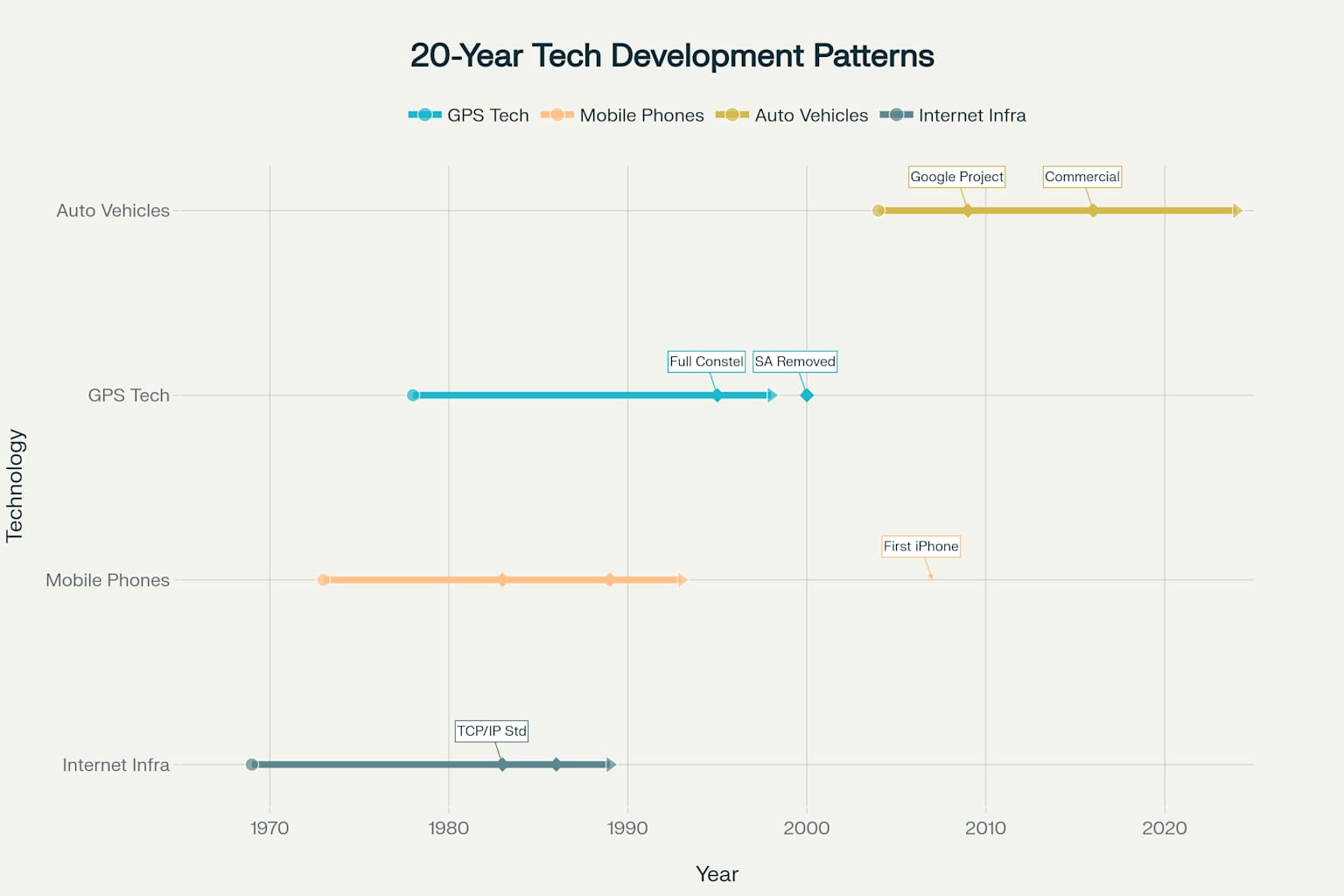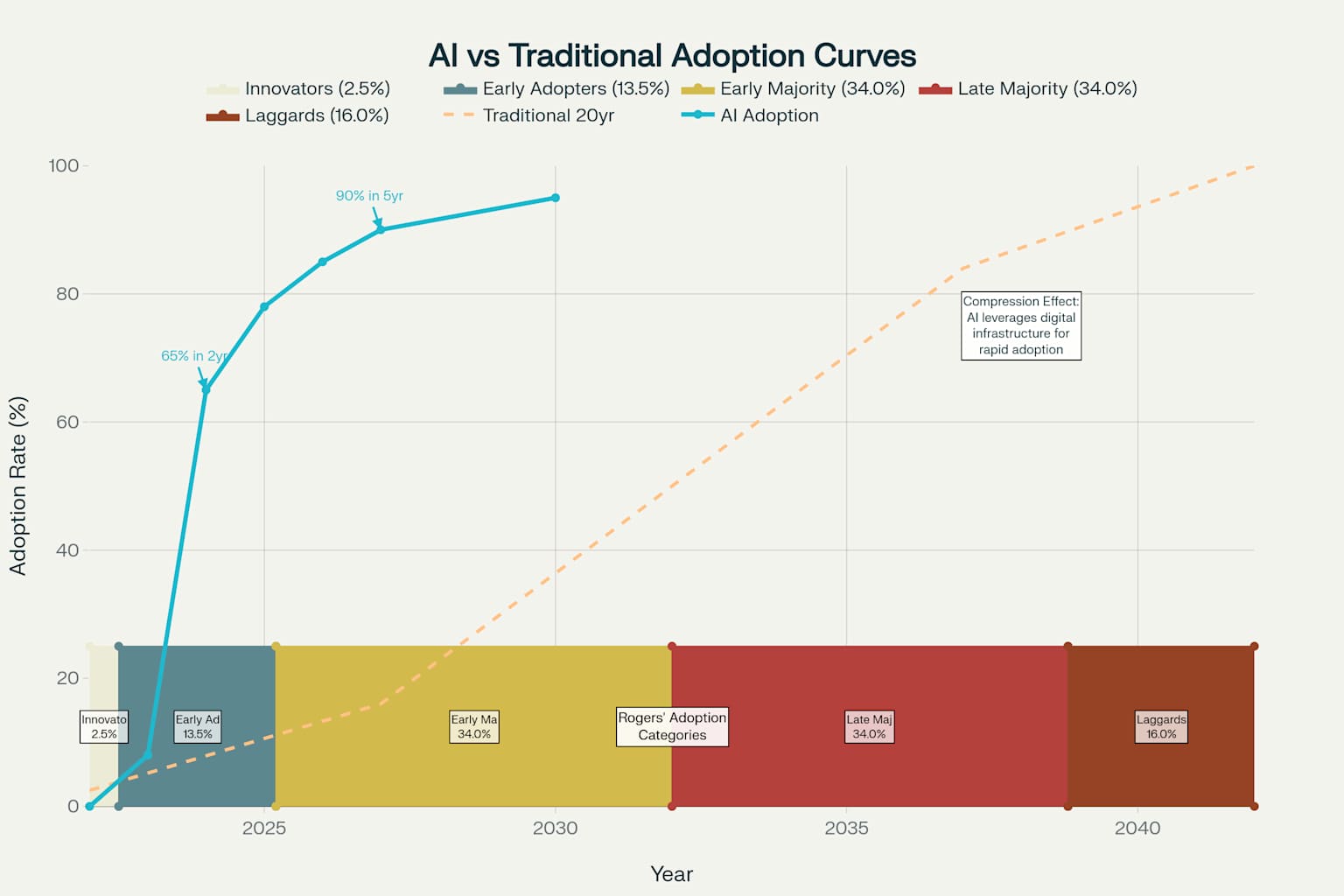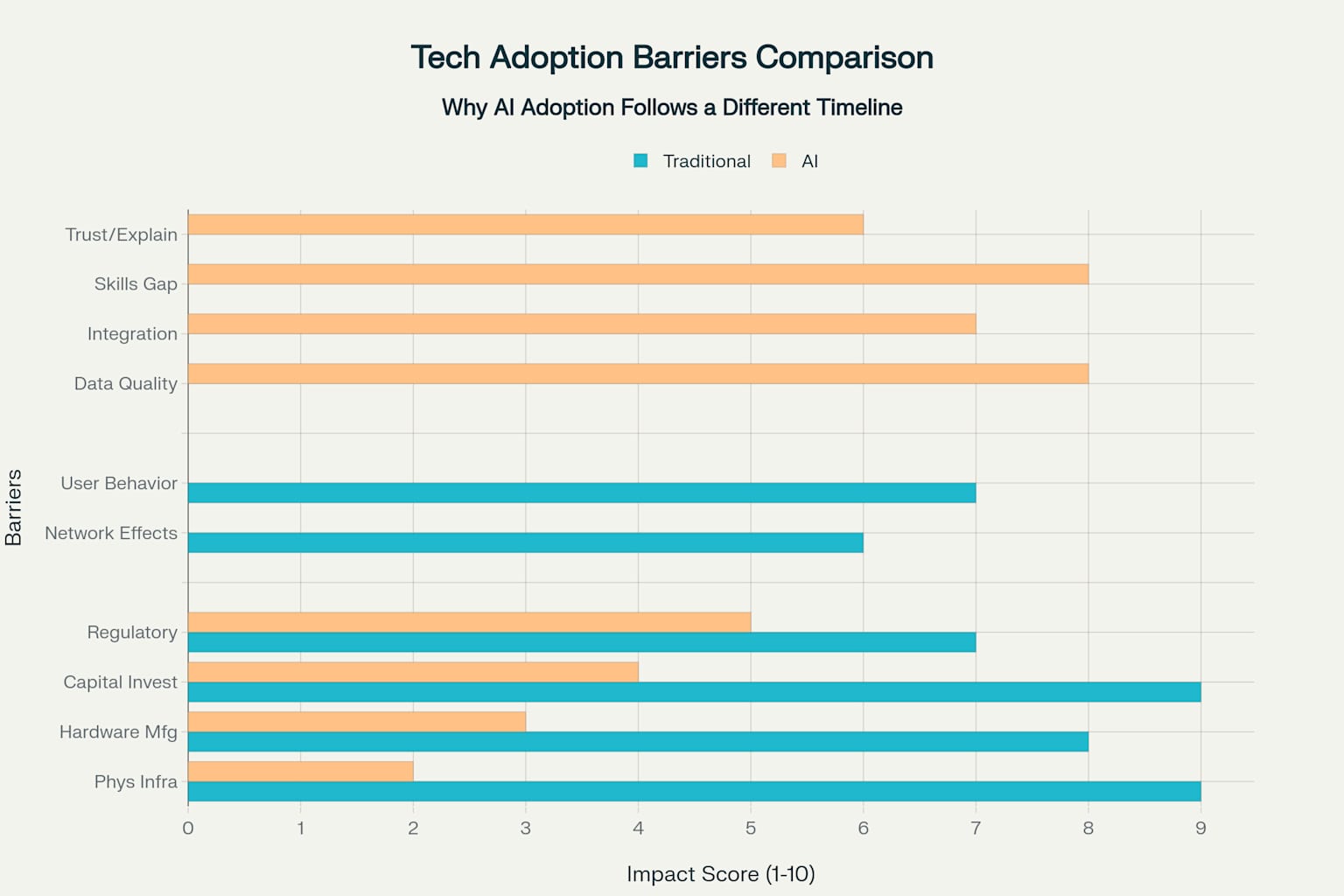The 20-Year Technology Adoption Cycle and AI's Acceleration
TL;DR >> Infrastructure technologies historically take 20 years to reach critical mass adoption (GPS, mobile, autonomous vehicles). AI breaks this pattern, achieving rapid shallow adoption through existing digital infrastructure, but faces new barriers transitioning to deep societal integration by 2030-2040. <<
More than 90% of this article was written by AI. While that doesn't mean it's total garbage, you should skim read it with appropriate context.
# From Infrastructure to Intelligence and the Future of AI Integration
The transition from technological innovation to ubiquitous societal adoption has historically followed remarkably consistent patterns. An analysis of foundational infrastructure technologies reveals a persistent 20-year cycle from initial demonstration to achieving critical mass, fundamentally reshaping how societies operate. However, the emergence of artificial intelligence represents a paradigm shift that challenges these established timelines, compressing decades of adoption into years while simultaneously raising profound questions about the depth and sustainability of integration. Understanding these patterns provides crucial insights for anticipating AI’s trajectory beyond current shallow implementations toward genuine societal transformation.
# The Validated 20-Year Infrastructure Pattern
Establishing the Framework
The concept of a 20-year adoption cycle for transformative technologies finds robust empirical support across multiple domains. Research consistently demonstrates that infrastructure-heavy innovations require approximately two decades to progress from initial technological demonstration to achieving critical mass penetration of 10-20% of their target market12. This threshold represents the tipping point where adoption becomes self-sustaining through network effects, social proof, and economic viability3.
The 20-year pattern emerges from the convergence of multiple factors: the time required to build physical infrastructure, achieve regulatory approval, reduce costs through economies of scale, and overcome behavioral resistance to change2. These technologies fundamentally alter how society operates rather than simply improving existing processes, necessitating comprehensive systemic transformation.

The 20-Year Infrastructure Technology Adoption Pattern: From Innovation to Critical Mass
Case Studies in Infrastructure Adoption
Global Positioning System (GPS) exemplifies this pattern perfectly. The first GPS satellite launched in 1978, but consumer-grade navigation devices only achieved widespread adoption in the late 1990s. The critical catalyst occurred in May 2000 when the U.S. government discontinued Selective Availability, removing intentional signal degradation and enabling accurate civilian use. This policy change, combined with miniaturization and cost reduction, transformed GPS from a military tool to a consumer necessity exactly 22 years after initial deployment.
Mobile Communications followed an identical trajectory. Martin Cooper made the first mobile phone call on April 3, 1973, but mass market penetration didn’t occur until the mid-1990s when cellular networks became ubiquitous and devices became affordable. The transition from analog to digital networks in the late 1980s provided the technological foundation, but widespread adoption required infrastructure build-out and dramatic cost reductions.
Autonomous Vehicles validate this pattern in contemporary terms. The 2004 DARPA Grand Challenge marked the beginning of serious autonomous vehicle development, and Waymo’s commercial robotaxi service launched in San Francisco in June 2024 – exactly 20 years later. This timeline encompasses the development of sensor technologies, machine learning algorithms, regulatory frameworks, and public acceptance necessary for commercial deployment.
Internet Infrastructure also confirms the pattern when properly analyzed. The foundational TCP/IP protocol was standardized in 1983, and commercial Internet service providers emerged around 1989-1991, representing approximately 6-8 years for basic infrastructure. However, meaningful e-commerce adoption didn’t occur until the mid-1990s with Amazon and eBay, and true mass adoption required the additional infrastructure of the World Wide Web, broadband connectivity, and widespread computer ownership.
Critical Mass Theory and Infrastructure Technologies
The 20-year pattern aligns with established diffusion of innovation theory, particularly Rogers’ five-stage adoption process and the concept of critical mass14. Critical mass occurs when sufficient adopters exist to make continued adoption self-sustaining3. For infrastructure technologies, this threshold is higher because network effects are crucial – the value of the technology increases exponentially with the number of users.
Research indicates that critical mass for interactive technologies typically occurs between 10-20% market penetration23. At this point, the technology transitions from external marketing-driven growth to organic, internally-driven expansion. Early adopters provide social proof for the early majority, while economies of scale reduce costs and improve performance45.
The technological take-off concept describes this transition as a fundamental transformation in diffusion dynamics2. Before critical mass, adoption is slow and requires significant marketing effort. After the threshold, growth becomes exponential and self-perpetuating, driven by network effects, word-of-mouth promotion, and competitive pressure2.
# AI’s Accelerated Adoption Timeline
Breaking the 20-Year Rule
Artificial intelligence represents a fundamental departure from historical adoption patterns. While foundational infrastructure technologies required two decades to achieve critical mass, AI has compressed this timeline dramatically. ChatGPT gained 100 million users within two months of launch[previous research], and enterprise adoption surveys indicate that 65% of organizations now use generative AI in some capacity as of 20246.
This acceleration occurs because AI leverages existing digital infrastructure rather than requiring new physical systems. Unlike GPS satellites, cellular towers, or autonomous vehicle manufacturing, AI deployment requires primarily software distribution through established internet and cloud computing platforms76. The marginal cost of distributing AI capabilities approaches zero once the foundational models are developed.

Rogers’ Innovation Adoption Curve vs. AI’s Accelerated Adoption Timeline (2022-2030)
The Infrastructure Advantage
AI’s rapid adoption reflects what researchers term “infrastructure leverage” – the ability to build upon decades of prior technological investment89. The internet, cloud computing, and mobile devices provide a ready-made distribution and execution platform for AI services. This eliminates the lengthy infrastructure development phase that characterized previous transformative technologies.
Current enterprise adoption data supports this acceleration. According to comprehensive surveys, AI investments are growing at 14% year-over-year in 2025, with 30% of technology-advanced companies successfully implementing AI at scale10. Moreover, the shift from innovation budgets to core operational budgets indicates that AI is transitioning from experimental to essential business infrastructure11.
However, this rapid adoption primarily represents what can be characterized as “shallow integration” – the use of AI tools for productivity enhancement and process optimization rather than fundamental transformation of business models or social structures1012. Organizations report significant challenges in moving beyond basic implementations to achieve deep, strategic integration13.
Distinguishing Shallow from Deep Adoption
The current AI adoption wave exhibits characteristics of shallow integration across multiple dimensions. Enterprise surveys reveal that while 65% of organizations use generative AI, only 26% of those identifying as “advanced” have successfully delivered AI use cases to market10. This gap indicates widespread experimentation without systematic deployment.
Shallow adoption characteristics include:
- Point solutions addressing specific tasks rather than integrated workflows
- Limited data integration across organizational systems
- Reactive implementation driven by competitive pressure rather than strategic vision
- Focus on productivity gains rather than business model transformation
- Minimal organizational restructuring or process redesign101213
Deep adoption requires:
- End-to-end workflow integration across business functions
- Comprehensive data governance and quality management systems
- Strategic alignment between AI capabilities and business objectives
- Organizational culture changes to support human-AI collaboration
- Development of AI-native business processes and decision-making frameworks1214
# Barriers to Deep AI Integration
Technical and Organizational Challenges
Despite rapid initial adoption, organizations face significant barriers to achieving deep AI integration. Research identifies multiple constraint categories that differ markedly from traditional infrastructure adoption challenges151316.

Adoption Barriers: Traditional Infrastructure Technologies vs. AI
Data Quality and Governance emerge as the primary bottleneck for deep AI integration. Unlike traditional technologies that required physical infrastructure, AI systems depend entirely on high-quality, well-governed data sources1513. Organizations report that inadequate data management practices, fragmented information systems, and poor data quality prevent effective AI deployment even when technical capabilities exist1617.
Integration Complexity represents another critical barrier. While AI tools can be deployed quickly as standalone solutions, integrating them into existing enterprise systems requires substantial technical effort131617. Legacy system compatibility, API limitations, and security constraints often prevent seamless integration, limiting AI to peripheral applications rather than core business processes.
Skills Gaps constitute a persistent challenge across all organizational levels151318. Organizations need not only technical AI expertise but also professionals who can bridge technology and business domains. The shortage of AI-literate managers, data scientists, and integration specialists creates bottlenecks that slow deep adoption regardless of technological capability19.
Regulatory and Governance Uncertainty increasingly constrains AI deployment as organizations await clearer regulatory frameworks1018. The EU AI Act and similar legislation create compliance obligations that organizations struggle to interpret and implement, leading to cautious, limited deployments rather than comprehensive integration20.
Organizational and Cultural Factors
Beyond technical challenges, deep AI integration requires fundamental organizational transformation that many enterprises resist or manage poorly. Research indicates that successful AI transformation demands changes across seven key dimensions: strategy, governance, data management, technology architecture, workforce development, partnerships, and cultural adaptation122122.
Cultural resistance emerges as a significant barrier, with employees expressing concerns about job displacement, algorithmic bias, and loss of human agency1923. Organizations report that managing change management and ensuring workforce buy-in requires substantial investment in training, communication, and psychological support1619.
Trust and explainability concerns limit AI deployment in critical decision-making contexts. Organizations hesitate to deploy AI systems for high-stakes decisions when they cannot explain algorithmic reasoning or ensure consistent, fair outcomes1816. This constraint particularly affects deep integration scenarios where AI would assume significant autonomous decision-making authority.
# Predicting AI’s Future Trajectory: From Shallow to Deep Integration
The Coming Transformation Phase (2025-2030)
Current indicators suggest that AI adoption is approaching an inflection point where shallow integration begins transitioning toward deeper systemic transformation. Several converging trends support this prediction72425.
Agentic AI Development represents the most significant near-term advancement. By 2030, AI systems are projected to evolve from reactive tools to autonomous agents capable of independent decision-making and goal-oriented actions7. Microsoft and other major platforms are developing AI agents that can manage complex workflows across multiple systems, representing a fundamental shift from tool-based to partnership-based human-AI interaction7.
Multimodal Integration will enable AI systems to process text, images, audio, and sensor data simultaneously, creating more sophisticated understanding of context and user needs724. This capability advancement removes current limitations that restrict AI to narrow, text-based applications and enables integration into physical environments and complex operational contexts.
Infrastructure Maturation through edge computing, 5G networks, and specialized AI hardware will enable real-time, low-latency AI deployment in previously inaccessible environments268. This infrastructure development parallels the connectivity expansion that enabled mobile device ubiquity and will similarly catalyze AI integration into ambient computing environments.
Toward Ambient Intelligence and Ubiquitous Computing
The ultimate expression of deep AI integration involves the emergence of ambient intelligence – AI systems embedded seamlessly into physical environments that anticipate and respond to human needs without explicit interaction272829. This represents a qualitative transformation from current tool-based AI interactions to truly integrated technological environments.
Ambient Intelligence Characteristics:
- Context-aware systems that detect and interpret environmental cues automatically
- Personalization engines that learn individual preferences and adapt behaviors accordingly
- Anticipatory systems that predict needs and take proactive actions
- Seamless integration across devices, platforms, and environments273031
Research suggests that ambient computing will become pervasive by 2030-2040, with AI systems managing home environments, urban infrastructure, healthcare monitoring, and workplace coordination without conscious human intervention72831. This transition represents the full realization of ubiquitous computing visions articulated in the 1990s but enabled by contemporary AI capabilities2728.
Smart Environment Evolution will progress through several phases:
- 2025-2027: AI-enhanced smart homes and offices with voice/gesture control
- 2027-2030: Proactive environmental management based on learned preferences
- 2030-2035: Fully ambient intelligence with predictive, adaptive environments
- 2035-2040: City-scale intelligent infrastructure with autonomous optimization73228
Critical Enablers for Deep Integration
Successfully transitioning from shallow to deep AI integration requires addressing multiple systemic challenges simultaneously. Organizations and societies that effectively manage these transitions will capture disproportionate value from AI capabilities121122.
Data Infrastructure Development must progress beyond current fragmented approaches toward comprehensive data mesh architectures that enable AI systems to access and integrate information across organizational boundaries1214. This requires substantial investment in data governance, quality management, and interoperability standards.
Regulatory Framework Maturation will provide necessary certainty for organizations to invest in deep AI integration101820. Clear guidelines on algorithmic accountability, bias prevention, and human oversight will enable enterprises to deploy AI systems in critical contexts currently considered too risky.
Workforce Evolution must address both technical skills development and broader organizational capability building121819. Successful organizations will invest heavily in AI literacy across all roles, develop human-AI collaboration processes, and redesign workflows to leverage AI capabilities effectively.
Ethical AI Governance will become essential as AI systems assume greater decision-making authority181629. Organizations must develop frameworks for ensuring algorithmic fairness, maintaining human agency, and preserving social values as AI integration deepens.
# Implications for Future Societal Transformation
Timeline Projections and Critical Milestones
Based on current adoption trends and historical patterns, AI’s progression toward deep societal integration will likely follow a compressed but still multi-phase timeline:
2025-2027: Infrastructure Consolidation Phase
- Enterprise AI integration reaches 80-85% adoption rates
- Regulatory frameworks stabilize, enabling broader deployment
- AI agent technologies mature for complex workflow management
- Data governance standards emerge and gain widespread adoption10117
2027-2030: Systemic Integration Phase
- AI becomes embedded in critical infrastructure systems
- Ambient intelligence deployments begin in controlled environments
- Human-AI collaboration models mature in professional contexts
- Regulatory and ethical frameworks adapt to autonomous AI systems72432
2030-2035: Ubiquitous Deployment Phase
- AI systems manage significant portions of urban infrastructure
- Ambient computing becomes standard in residential and commercial environments
- AI-mediated decision-making becomes routine in healthcare, education, and governance
- New generations develop as “AI natives” with fundamentally different technology relationships73328
2035-2040: Full Societal Integration
- AI systems coordinate complex multi-domain challenges like climate adaptation
- Human-AI collaborative governance models emerge for complex social problems
- Economic and social structures adapt to ubiquitous AI capabilities
- Critical mass achieved for AI-transformed societal operations3234
Managing the Transition Risks
The compressed timeline for AI integration creates unique risks that differ from historical technology transitions. The speed of change may outpace institutional adaptation capabilities, creating social instability, economic disruption, and governance challenges353334.
Economic Displacement will likely accelerate as AI capabilities expand from manual tasks to knowledge work and creative activities363738. Unlike previous technological transitions that created new job categories over decades, AI advancement may eliminate entire professional categories within years, requiring unprecedented social support and retraining systems.
Democratic and Governance Challenges emerge as AI systems assume decision-making roles traditionally reserved for human institutions352934. Ensuring accountability, transparency, and democratic control over AI-mediated governance requires developing new institutional frameworks before AI capabilities outpace oversight mechanisms.
Social Cohesion Risks may result from uneven AI access, algorithmic bias, and loss of human agency in critical life domains352934. Managing these transitions requires proactive policy intervention to ensure equitable AI benefits and preserve human autonomy in an AI-integrated society.
# Conclusion: Navigating the Acceleration
The 20-year technology adoption cycle represents a robust pattern for infrastructure-dependent innovations, but AI’s unique characteristics enable dramatically accelerated timelines that compress traditional adoption phases. While current AI adoption remains largely shallow, focusing on productivity enhancement rather than systemic transformation, multiple indicators suggest an approaching transition toward deep integration characterized by ambient intelligence and ubiquitous computing.
Successfully managing this transition requires recognizing that AI adoption follows fundamentally different dynamics than previous transformative technologies. The absence of physical infrastructure requirements enables rapid deployment, but the complexity of data integration, organizational transformation, and ethical governance creates new categories of adoption barriers. Organizations and societies that proactively address these challenges will capture disproportionate benefits from AI capabilities, while those that remain passive risk being left behind in an increasingly AI-integrated world.
The ultimate trajectory toward ambient intelligence and AI-mediated societal coordination appears increasingly probable, but the specific timeline and outcomes remain contingent on our collective choices regarding regulation, ethics, workforce development, and democratic governance. Unlike previous technology transitions that unfolded over decades, AI’s acceleration demands immediate attention to long-term implications and proactive management of transformation processes.
The evidence suggests we are approaching a critical juncture where shallow AI adoption begins transitioning toward deep integration. How effectively we navigate this transition will determine whether AI fulfills its potential as a tool for human flourishing or becomes a source of disruption and inequality. The window for shaping this trajectory remains open, but the pace of change demands urgent, comprehensive, and coordinated action across all dimensions of society.
# Footnotes
-
https://www.epam.com/about/newsroom/press-releases/2025/what-is-holding-up-ai-adoption-for-businesses-new-epam-study-reveals-key-findings ↩ ↩2
-
https://www.workhuman.com/blog/challenges-of-ai/ ↩ ↩2 ↩3 ↩4 ↩5
-
https://ec.europa.eu/eurostat/statistics-explained/index.php/Use_of_artificial_intelligence_in_enterprises ↩ ↩2
-
https://www.dynaminds.ai/7-pillars-of-successful-ai-transformation-framework.html ↩ ↩2
-
https://a16z.com/ai-enterprise-2025/ ↩ ↩2 ↩3 ↩4 ↩5 ↩6 ↩7 ↩8 ↩9 ↩10
-
https://www.simplilearn.com/challenges-of-artificial-intelligence-article ↩ ↩2
-
https://www.valsoftcorp.com/news/the-4-phase-ai-transformation-roadmap-a-comprehensive-guide/ ↩
-
https://www.coherentsolutions.com/insights/ai-adoption-trends-you-should-not-miss-2025 ↩ ↩2 ↩3 ↩4 ↩5 ↩6 ↩7
-
https://talkthinkdo.com/blog/ai-integration-challenges/ ↩ ↩2 ↩3
-
https://www.gartner.com/en/articles/ai-roadmap ↩ ↩2 ↩3 ↩4 ↩5 ↩6 ↩7
-
https://www.mckinsey.com/capabilities/quantumblack/our-insights/the-state-of-ai ↩ ↩2 ↩3 ↩4 ↩5 ↩6
-
https://www.frasertec.com/en/blog/ai-integration-challenges-hk-business-erp-crm-scm ↩ ↩2
-
https://www.microsoft.com/en-us/microsoft-cloud/blog/2024/04/03/the-ai-strategy-roadmap-navigating-the-stages-of-value-creation/ ↩ ↩2 ↩3
-
https://www.goldmansachs.com/insights/articles/the-outlook-for-ai-adoption-as-advancements-in-the-technology-accelerate ↩ ↩2 ↩3 ↩4 ↩5 ↩6
-
https://www.glideapps.com/blog/challenges-implementing-ai ↩ ↩2
-
https://www.weforum.org/press/2025/01/advancing-ai-transformation-a-roadmap-for-businesses-and-governments/ ↩ ↩2 ↩3 ↩4 ↩5 ↩6
-
https://ff.co/ai-statistics-trends-global-market/ ↩ ↩2 ↩3 ↩4
-
https://dev.to/alona_instandart/ai-integration-into-legacy-systems-challenges-and-solutions-fdj ↩ ↩2
-
https://www.techtarget.com/whatis/feature/Diffusion-of-innovations-theory-Definition-and-examples ↩
-
https://www.hightechstrategies.com/innovation-adoption-curve/ ↩ ↩2
-
https://www.econstor.eu/bitstream/10419/173322/1/wp-gut-fme-a-26-Lechman.pdf ↩
-
https://www.investopedia.com/terms/d/diffusion-of-innovations-theory.asp ↩ ↩2 ↩3
-
https://www.valuebasedmanagement.net/methods_rogers_innovation_adoption_curve.html ↩
-
https://en.wikipedia.org/wiki/Critical_mass_(sociodynamics) ↩
-
https://www.linkedin.com/pulse/empowering-innovation-how-ai-drives-technology-adoption-rajoo-jha-3nv0c ↩ ↩2 ↩3
-
https://confidentchangemanagement.com/change-models/rogers-adoption-curve/ ↩ ↩2 ↩3 ↩4 ↩5
-
https://www.econstor.eu/bitstream/10419/29804/1/616095813.pdf ↩ ↩2 ↩3 ↩4
-
https://growenterprise.co.uk/2023/03/06/what-is-the-adoption-curve-of-innovation-and-how-does-it-work/ ↩ ↩2
-
https://www.redalyc.org/journal/4991/499151081002/499151081002.pdf ↩ ↩2
-
https://onlinelibrary.wiley.com/doi/abs/10.1111/joie.12176 ↩ ↩2 ↩3
-
https://www.sciencedirect.com/science/article/pii/S0040162522003456 ↩
-
https://en.wikipedia.org/wiki/Technology_adoption_life_cycle ↩
-
https://www.tandfonline.com/doi/abs/10.1057/palgrave.ejis.3000680 ↩